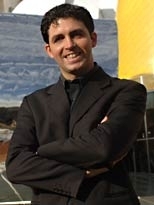Manolis Kellis, a young and fast-rising MIT researcher, uses sophisticated computational tools to investigate the genomes of a variety of organisms, including humans, mice, fruit flies and yeast, and the insights emerging from that work could lead to important findings about human development and disease.
The work marks the early stages of a whole new field of comparative genomics, in which insights about individual species can be derived by studying the similarities and differences in the genomes of many different species. The method can probe the evolutionary process to reveal previously unknown mechanisms, suggesting specific hypotheses that can advance biological knowledge.
"This represents a new phase in genomics--making biological discoveries sitting not at the lab bench, but at the computer terminal," Kellis says.
It was partly a typical MIT kind of serendipity that first got him interested in the field. While still a graduate student in computer science at MIT, he ran into a friend who was reading a biology book and the two started talking about genetics and evolution. Kellis soon was shown one of the first assemblies of the human genome on a computer screen, which he said was like looking in a mirror, and he "could never look back." Soon the friend introduced him to Eric Lander, who eventually became his thesis advisor.
Lander, director of the Broad Institute of MIT and Harvard, describes his former student as an "awesome" person.
"He's a perfect example of how the world of biology has undergone just a dramatic transformation," Lander says. The genomic revolution is providing "a whole new biology that can only be done by analyzing massive data sets. What is required is both biological knowledge and algorithmic and mathematical skills."
"It's still very rare in the world," Lander says, to find people with strong skills in both fields. "He's a whirlwind of energy, positive and energetic. He works around the clock, always with a smile, always enthusiastic."
Even as a graduate student, Lander recalls, Kellis was doing amazing work. Lander suggested he work on a thesis project to compare the entire genomes of four species of yeast. "I neglected to mention that nobody had ever done anything as ambitious as that, much less a graduate student," Lander admits. "He proceeded to do amazing things with it, and ended up publishing several landmark papers in Nature--which is unheard of for a computer science graduate student."
Kellis grew up in Athens, Greece, before moving to France when he was 12, and to New York in his teens. He and his brother and sister were all admitted to MIT in the same year. He earned his BS, MEng and PhD here, and was appointed to the faculty in 2004. He is now the Karl Van Tassel Career Development Assistant Professor in the Department of Electrical Engineering and Computer Science, and a member of the Computer Science and Artificial Intelligence Lab and of the Broad Institute. At 30, he has already earned numerous awards and accolades, including a National Science Foundation Career Award last year and a place in Technology Review magazine's 35 innovators under 35 for 2006.
Among Kellis' research subjects is recognizing functional elements in DNA, based on their patterns of change across different species that contain them--often separated by millions of years of evolution--revealing the specific functions of those regions. His lab has used such methods to discover protein-coding genes, as well as RNA genes, micro-RNAs and DNA patterns involved in gene regulation, which govern when genes are turned on or off.
"When we find a region of high sequence conservation in the genomes of distantly related species, we know it is under selective constraints and probably gives the organism a selective advantage," Kellis says. Conservation shows that these sequences are important, even without knowing what they actually do. By studying more closely the patterns of change within these elements, researchers can go a step further and recognize their precise function.
A recent project that Kellis co-led, along with a large team of researchers here and at several other institutions, mapped and analyzed the genomes of 12 different species of fruit flies--the largest project yet comparing different -genomes. It produced more than 40 papers published over the last three months in Nature and several other journals.
"Comparative genomics had never been done at this scale before," Kellis says.
The techniques Kellis and his colleagues developed "can now be used to discover functional regions in any genome, including the human," Kellis says. He and his colleagues have moved on to a similar, even-more-massive project to map the genomes of 24 species of mammals.
The work aims to find out not just what is contained in strands of DNA--the sequence of genes and other information encoded on the long chains--but how it all functions as a system. "We want to make sense of the cell's circuitry at a systems level," Kellis says. "How is the genome controlling all of the cell's differentiation processes, the minutely choreographed dance of genes and regulators during development?"
The software tools that Kellis and his team developed also provide a new way of finding the stretches of DNA that represent genes or regulatory elements, buried within the much longer stretches that have no known function.
Despite his energetic pace of work, Kellis still finds time to enjoy the pleasures of life. He remains active in sailing, traveling, photography, and in Greek dancing and cuisine.
"He makes a great Greek halvah," Lander says. "He's just delightful. He's one of my kids' favorite people."
A version of this article appeared in MIT Tech Talk on February 6, 2008 (download PDF).






